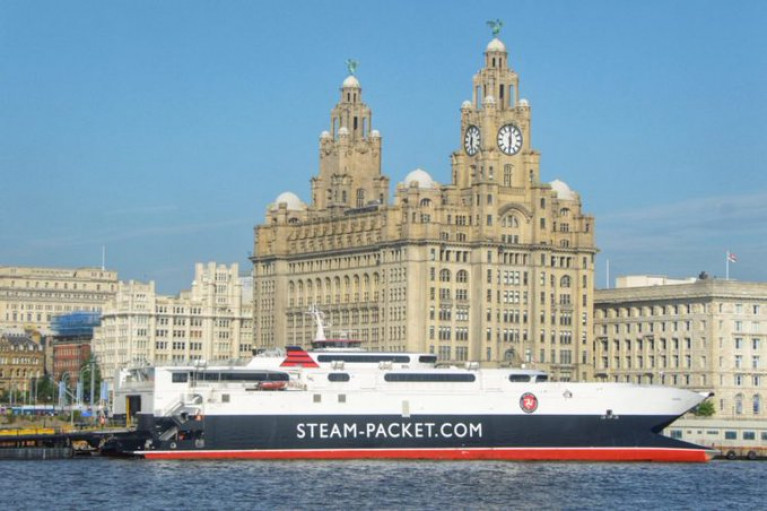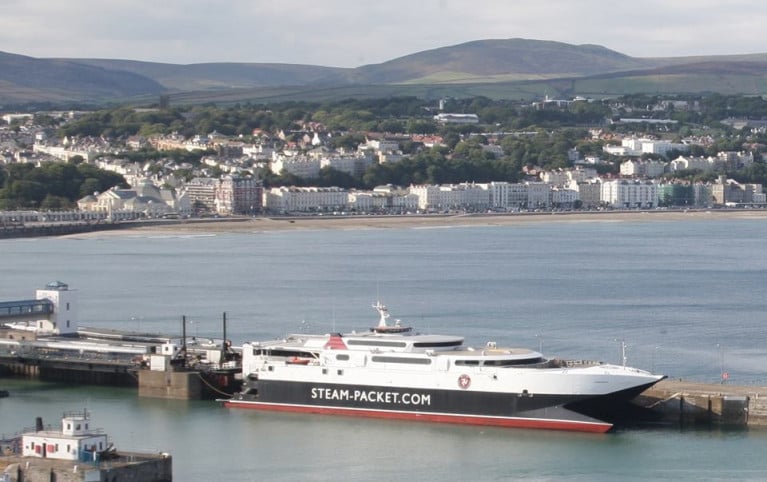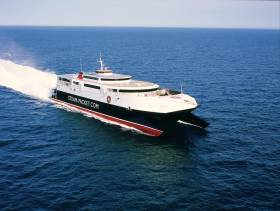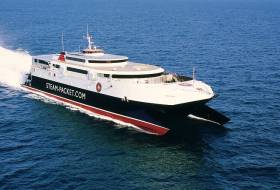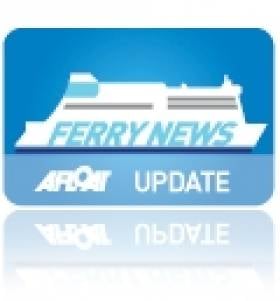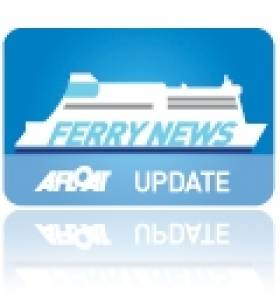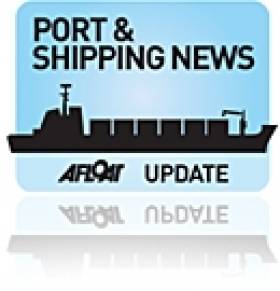Displaying items by tag: Fastferry
Isle of Man Fast-Craft Ferry to Resume Seasonal Sailings to Liverpool, Belfast & Dublin
Fastcraft ferry Manannan of the Isle of Man Steam Packet will resume seasonal sailings between Douglas Harbour and Liverpool (2hrs 45mins) on Friday 1 April, reports Manx Radio.
The 865 passenger/200 vehicle InCat 96m craft will undertake crossings to Belfast Harbour (3hrs) from 13 April, and Dublin Port (2hrs 55mins) on 14 April.
Brian Thomson, managing director of the Isle of Man Steam Packet Company, said: "With travel on and off the Island opening-up after a challenging couple of years, following the outbreak of Covid-19, it’s wonderful to see many residents and visitors alike using the Steam Packet Company to take a well-earned holiday."
Afloat adds the Steam-Packet has conventional tonnage with the ropax Ben-My-Chree which operates year-round sailings on the operator's main route of Douglas-Heysham.
During the summer, the 'Ben' will also operate occasional sailings on the Belfast-Douglas route which takes a 5 hour passage.
Douglas-Liverpool Fast-Ferry Craft Crossings Resume
Ferry sailings linking Douglas, Isle of Man and Liverpool have resumed for the first time this year following the easing of the island's border restrictions.
As BBC News writes, limited passenger demand had seen the Ben-my-Chree operate only Heysham services.
The Manannan traditionally starts its Liverpool crossings in March each year.
Almost 600 passengers were due to travel on Thursday, the Isle of Man Steam Packet Company said.
The majority of those people were due to arrive on the island from Liverpool on the afternoon and evening return crossing.
Changes to the island's border restrictions mean that people from the UK, Ireland and Channel Islands who have been fully vaccinated against Covid-19 for at least two weeks can travel to the island freely without testing or isolation.
About 31,600 passengers have booked to travel on the Steam Packet vessels during July, 16,955 of which are due to sail on the Manannan
Fast Craft On Isle of Man Routes Returns to Service
#ferries - Fast craft sailings of the Isle of Man Steam Packet Company's catamaran resumed daily sailings (yesterday) to Liverpool for the summer.
As BBC News writes the catamaran Manannan will also begin routes to Belfast and Dublin in April.
"We are excited to welcome passengers on board, both island residents heading off on holiday and visitors coming to explore our island," said the company's chief executive Mark Woodward.
Isle of Man's Fastferry Manannan Medical Emergency
#FerryNews - Isle of Man Steam Packet's fastferry Manannan has been forced to turn around midway into a sailing to Liverpool (yesterday) morning.
A passenger reports Manx Radio took ill on board around half an hour into the crossing, requiring urgent medical attention.
The ferry returned to Douglas shortly before 9.30am, and set out to Liverpool again after the passenger was removed.
Day trip passengers and those who have had travel plans disrupted were offered the chance to disembark.
Last Fast Ferry Using Holyhead Will Become Summer Only Service
#fastferry - The introduction next year of a new cruise ferry between Holyhead and Dublin reports Daily Post will see the last fast ferry on the route cut to a summer only service.
Irish Ferries' new vessel W. B. Yeats - currently under construction at Flensburg, Germany - will start up on the Anglesey to Ireland route next September.
It will see the Jonathan Swift docked for winter - with the boat returning in April 2019. This happened to the Stena Line fast boat - the Explorer - until it was phased out completely in 2015.
The W. B. Yeats - sailing alongside the Ulysses - will increase capacity over the winter but passengers will lose the option of the quick crossing.
Fast ferry sailings take around 1hr 50 mins, compared to more than 3 hrs on the other vessels.
One issue of concern for Holyhead is a step up in summer sailings by Irish Ferries between Ireland and France - with the W. B. Yeats switching to these routes between April and September. It doubles the number of summer sailings between Ireland and France.
To read more click here and as reported on Afloat, concerns from Holyhead after Brexit as increased freight and passenger capacity is to operate from Ireland direct to mainland Europe.
Strong Winds Cancel Central Corridor Fast-Ferry Sailings
Stena Line's Dublin-Holyhead sailings are on schedule in addition to services on the Rosslare-Fishguard, Belfast-Stranraer (incl. HSS sailings) and Belfast-Liverpool. P&O's Dublin-Liverpool and North Channel Larne-Cairnryan route are also on schedule.
On the Celtic Sea, Fastnet Line's Cork-Swansea is unaffected as there are no sailings on Monday's, Tuesday's and Wednesday's during this month and November. The next sailing is this Thursday from Cork at 20.30hrs and returning Swansea on Friday at 21.30hrs.
According to Met Eireann, this afternoon will be extremely windy, especially across the southern half of the country, with southwest gusts of between 90 and 120km/h. For more detailed and updated weather forecasts visit www.met.ie
Seasonal Scenes Set for Fishguard
Fast-ferry Stena Lynx III departed Dun Laoghaire for Fishguard Harbour on a repositioning voyage today, writes Jehan Ashmore.
The 80m craft built in Hobart, Tasmania is due to dock at the Pembrokeshire port this afternoon in advance of seasonal sailings on Stena Line's Fishguard-Rosslare.The Stena 'Express' fast-ferry service is to resume in just over a fortnight's time. Sailings are scheduled to a daily single round trip between 1 July-4 September.
The 627 passenger / 120 car capacity fast-ferry will operate in tandem with the year-round operated conventional ferry-service served by the Stena Europe. Passage times are 120 minutes for the fast-ferry service while the Stena Europe takes 3 hours 30 minutes to sail across the St. Georges Channel.
In the same week that the fast-ferry takes up summer sailings from Fishguard, the small French flagged cruiseship Le Diament is to make the first of three calls in July and once in August.
The motoryacht-like vessel which can accommodate 226 passengers is the first cruise caller of the season and is run by the only French-owned cruise operator Compagnie De Iles Du Ponant.
Stena to Re-Introduce HSS this Week
Stena Line's HSS fast-ferry the Stena Explorer will be re-introduced on its Dun Laoghaire to Holyhead route this Friday, writes Jehan Ashmore.
The HSS (High Speed Service) operated 19,638 tonnes craft will run between 1 April to 13 September to cope with the additional demand over the summer period.
A single daily round trip is scheduled with a 10.00 hours sailing from Holyhead and a 13.15 hours sailing from Dun Laoghaire. Passage time is 120 minutes (2 hours).
The HSS can 350 vehicles and with 1500 passengers, the craft can handle higher volumes of seasonal summer foot passengers compared to the last route serving vessel, the 4,113 tonnes Stena Lynx III. The return of the HSS service links in with those intending to make onward journeys from Dun Laoghaire's DART commuter rail service to Dublin city centre and beyond on the national rail network.
Up to early January the route had been served by the Stena Lynx III which remains moored alongside Dun Laoghaire's St. Michaels Wharf. The craft which can take 627 passengers and 120 cars and marketed as the Stena 'Express' is to resume high season sailings starting in July between Rosslare-Fishguard.
In total the company carries over two million passengers on its four Irish Sea routes each year. An additional route between Belfast-Liverpool (Birkenhead) was taken over by the Swedish owned ferry company from DFDS Seaways late last year, is subject to regulatory clearance.
Until such clearance has been granted, this route will be operated separately from all other Stena Line routes. In the meantime the company advise until further notice to make bookings which will remain acceptable through the use of the DFDS website.
HSS Fast-Craft to Return on Dun Laoghaire Route
According to Stena Line over 70% of its passengers business is carried by the HSS Stena Explorer in the high season. It is felt that the 1996 Finnish built fast-craft is better suited for the service due to a loyal customer base which was reflected by repeat bookings and their preference of the HSS craft on the 120 minute (2 hour) route.
A daily single round trip is scheduled with sailings from Dun Laoghaire to Holyhead departing at 13:15hrs. The corresponding sailing from the Anglesey port departs at 10.00hrs and arrives at the Irish port at 12 noon. Sailings will operate through the summer until 13 September.
From there on Stena will make a decision as to its continuing schedule, though it is widely believed that the prospects of the fuel-thirsty, expensive to run HSS fast-craft service are likely to be at an end of an era.
Last month negotiations over the core issue of harbour fees were held between Stena Line and Dun Laoghaire Harbour Company. It is understood that the annual fee of €6.5m was dropped to €2m. The board of the harbour company has given a 'conditional green light' of a new ferry contract to Stena Line to run the service for the next two years with an option of a third year.
The service closed for its seasonal break earlier this year on 5 January with the 'Lynx' going into temporary lay-up at Holyhead's inner harbour to join the HSS Stena Explorer. The HSS had been 'wintering' at the port since September sailings were taken over by the Lynx.
Earlier this month the Stena Lynx III came to Dun Laoghaire to continue her lay-up period. The 1996 Tasmanian built craft will stay there before resuming seasonal sailings between Rosslare-Fishguard in tandem with the conventional ferry Stena Europe.
In the meantime the craft is berthed at the harbour's two-berth ferry terminal at St. Michaels Wharf. The HSS berth is only designed for this type of fast-craft whereas the other berth now occupied by the Lynx was built originally for conventional ferries but was re-configured last year to suit the fast-craft.
The 'Lynx' Returns to Dun Laoghaire
on the Dun Laoghaire-Holyhead route, writes Jehan Ashmore.
ferry Stena Europe on the Rosslare-Fishguard route. Prior to then the Lynx craft also served Spring
sailings on the Dun Laoghaire-Holyhead service as a replacement vessel of the HSS Stena Explorer.
The reasoning for the change of vessels on the central Irish Sea route during the Spring and
forthcoming Autumn /Winter seasons is a cost-cutting measure on behalf of operators Stena Line.
The larger HSS craft is becoming increasingly more expensive to run using fuel thirsty gas-
turbine engines, compared to the smaller capacity Stena Lynx III, which can be used instead
during the quieter months.
Stena Explorer is to be withdrawn with the last round trip sailing tomorrow (14 September)
departing Holyhead at 10.00hrs and arriving at Dun Laoghaire at noon. Correspondingly the HSS departs
the Irish port at 13.15hrs and returns to the Welsh port two hours later.
On the following day (15 September) the Stena Lynx III will make her first outbound departure
from Holyhead at 10.00hrs arriving Dun Laoghaire at 11.50hrs. After a turn-around period in the Irish port
the Lynx departs at 13.15hrs with an arrival to the Anglesey port at 15.05hrs.


























